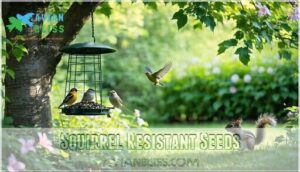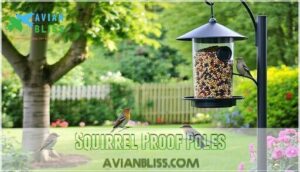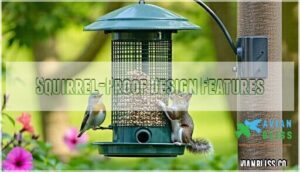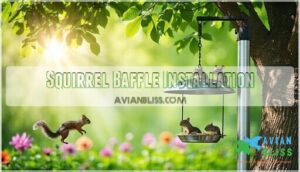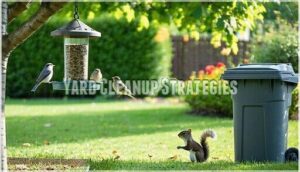This site is supported by our readers. We may earn a commission, at no cost to you, if you purchase through links.
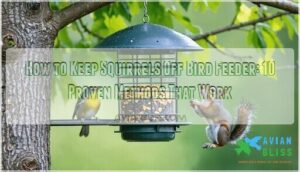 You’ll keep squirrels off your bird feeder by positioning it at least 10 feet from jumping surfaces and 5 feet high—these acrobatic raiders can’t bridge longer gaps.
You’ll keep squirrels off your bird feeder by positioning it at least 10 feet from jumping surfaces and 5 feet high—these acrobatic raiders can’t bridge longer gaps.
Install pole-mounted baffles below feeders or dome baffles above hanging models to create slippery barriers. Choose squirrel-resistant seeds like safflower or nyjer that taste bitter to squirrels but appeal to birds.
Caged feeders with 1.5-inch spacing allow small songbirds through while blocking larger squirrels. Strategic placement on smooth metal poles adds another defense layer.
These physical barriers work better than repellents because they address squirrels’ remarkable problem-solving abilities rather than relying on temporary deterrents, making them a more effective solution to keep squirrels away from your bird feeder with complete concepts in mind.
Table Of Contents
- Key Takeaways
- Squirrel Proof Bird Feeders
- Keep Squirrels Off Feeders
- Squirrel Resistant Seeds
- Deter Squirrels With Soap
- Squirrel Proof Poles
- Caged Bird Feeders
- Squirrel Baffle Installation
- Yard Cleanup Strategies
- Squirrel Repellent Plants
- Long Term Squirrel Control
- Frequently Asked Questions (FAQs)
- Why should I sprinkle coffee grounds around my bird feeder?
- What can I use to keep squirrels away from my bird feeders?
- What is the 5 7 9 rule for squirrels?
- What is the best homemade squirrel repellent?
- How to make bird feeder squirrel proof?
- How long does it take squirrels to give up?
- Can squirrels damage bird feeders over time?
- Do fake predators deter squirrels from bird feeders?
- Are there bird-friendly plants that squirrels dislike?
- What attracts squirrels to bird feeders initially?
- Conclusion
Key Takeaways
- Position your feeder strategically – You’ll need to place it at least 10 feet from jumping surfaces and 5 feet high, since squirrels cannot bridge longer gaps or reach higher poles without launching points.
- Install physical barriers like baffles – You should mount pole baffles below feeders or dome baffles above hanging models to create slippery surfaces that prevent squirrels from climbing or accessing from above.
- Choose squirrel-resistant seeds – You’ll have better success using safflower or nyjer seeds that taste bitter to squirrels but remain appealing to birds, or try capsaicin-treated seed mixes.
- Use caged feeders with proper spacing – You can allow small songbirds through while blocking squirrels by selecting feeders with 1.5-inch wire spacing and weight-activated mechanisms that close when heavier animals attempt access.
Squirrel Proof Bird Feeders
Squirrel-proof bird feeders utilize specific design features and strategic placement to prevent these agile rodents from accessing seed supplies.
Smart engineering beats squirrel acrobatics every time.
These specialized feeding systems incorporate physical barriers, elevation techniques, and baffle mechanisms that exploit squirrels’ jumping limitations while maintaining easy access for target bird species, utilizing strategic placement to ensure effectiveness.
Elevate Bird Feeders
Height matters when outsmarting these acrobatic raiders.
Position your squirrel proof bird feeders at least 5-6 feet high on sturdy bird feeder poles, ensuring 10 feet clearance from jumping surfaces.
Strategic feeder placement using appropriate mounting options creates an effective barrier.
Choose durable pole materials like steel or aluminum for reliable feeder height maintenance, making your squirrel proofing techniques truly effective.
Using the right squirrel proof feeders can substantially enhance the overall effectiveness of your bird feeder setup.
Use Squirrel-Proof Wire
Squirrel-proof wire creates an effective barrier around feeders through strategic material selection and placement.
Install 16-gauge galvanized wire mesh with quarter-inch openings around feeder perimeters. This wire thickness prevents squirrel access while allowing birds through.
Position wire cages six inches from all feeder surfaces. Proper cable management guarantees wire stability during weather conditions, making these squirrel deterrents highly effective for protecting bird seed supplies, which is a key factor in maintaining squirrel-proof feeders and ensuring the stability of the wire.
Invest in Squirrel Baffles
Baffle materials create physical barriers that exploit squirrel behavior patterns through strategic feeder placement.
These pole accessories represent effective wildlife control solutions for squirrel proof bird feeders.
- Dome baffles – Install 18 inches above ground on poles
- Wrap-around baffles – Secure tightly around feeder posts
- Torpedo baffles – Mount below hanging squirrel baffles
- Cage baffles – Surround entire bird feeder accessories
- Combination systems – Layer multiple squirrel deterrents together
Proper squirrel repellent positioning guarantees maximum effectiveness.
Keep Squirrels Off Feeders
Strategic feeder placement serves as your first line of defense against persistent squirrel invasions. Understanding squirrel behavior reveals their impressive athletic abilities: they can leap 10 feet horizontally and 4 feet vertically from any surface.
Implementing proper bird feeder tips requires positioning feeders at least 8 feet from trees, fences, or structures that provide launching platforms. Effective wildlife control depends on thorough yard sanitation practices. Remove fallen seeds daily, as these attract squirrels initially.
Strategic positioning combined with squirrel proofing techniques creates multiple barriers that discourage access. Using the squirrel proof methods can substantially reduce squirrel invasions on bird feeders.
| Distance Requirements | Minimum Clearance |
|---|---|
| From trees/structures | 8-10 feet |
| Height above ground | 5-6 feet |
| From fence lines | 6-8 feet |
Quality squirrel proof bird feeders incorporate weight-activated mechanisms that close feeding ports when squirrels attempt access. Squirrel baffles and squirrel repellent methods work most effectively when combined with proper placement strategies, creating thorough squirrel resistant feeders that protect your investment while ensuring birds maintain reliable food sources.
Squirrel Resistant Seeds
Certain seeds naturally repel squirrels while attracting songbirds, offering an effective biological solution to feeder raids.
Strategic seed selection creates a feeding environment where birds thrive and squirrels lose interest, establishing long-term protection without mechanical barriers, using biological solution.
Safflower Seed Benefits
Choosing safflower seed transforms your feeder into a squirrel-resistant zone while maintaining excellent bird attraction.
This high-protein, high-oil content seed provides essential nutrition with 350kcal per 100g and vitamin E levels reaching 35mg.
Cardinals increase visits by 30% when offered safflower, while squirrels consume less than 2% compared to sunflower seeds.
Proper seed storage maintains nutritional value and freshness for ideal feeding results, ensuring your feeder remains a squirrel-resistant zone.
Nyjer Seed Effectiveness
Nyjer seed offers exceptional squirrel resistance due to its small size and high oil content that squirrels typically avoid.
Field observations confirm squirrels consistently ignore nyjer feeders, even when seed spills on the ground.
This seed selection provides excellent bird feeding tips for finch attraction while eliminating most squirrel control methods.
Proper feeder placement with nyjer guarantees seed durability and reduces maintenance compared to other bird seed types requiring extensive squirrel exclusion methods.
Using a squirrel proof approach can further enhance the effectiveness of nyjer seed in deterring squirrels from bird feeders.
Spicy Seed Mixtures
Capsaicin-infused seed mixtures exploit the fundamental difference between mammalian and avian taste receptors. Birds lack capsaicin sensitivity, allowing them to consume spicy seeds without discomfort, while squirrels experience intense burning sensations that effectively deter feeding attempts.
Nature’s perfect defense system: birds can’t taste the heat, but squirrels feel the burn.
Consider these mixture recipes for effective squirrel control methods:
- Blend standard birdseed with 10% cayenne pepper powder for moderate capsaicin levels
- Mix safflower seeds with hot pepper flakes at 5% concentration for cost effectiveness
- Combine nyjer with commercial hot pepper oil coating for maximum squirrel sensitivity
This approach leverages natural squirrel behavior patterns while maintaining bird tolerance. Using natural squirrel deterrents can also enhance the effectiveness of these seed mixtures.
Deter Squirrels With Soap
You can hang bars of strong-scented soap like Irish Spring near your bird feeders to repel squirrels through their sensitive sense of smell.
This method works because squirrels dislike the potent fragrance, though you’ll need to replace the soap regularly as rain and weather reduce its effectiveness.
Irish Spring Soap Effectiveness
Irish Spring soap creates an initial scent deterrent that overwhelms squirrels’ sensitive noses, causing temporary avoidance of treated areas.
This animal repellent works through strong artificial fragrance that interferes with squirrel behavior patterns around bird feeder placement.
However, effectiveness diminishes quickly as squirrels adapt and weather reduces the soap’s potency, requiring frequent reapplication of soap granules for bird feeder maintenance.
Using a squirrel repellent method like squirrel deterrents can help keep squirrels away from bird feeders, which is an effective animal repellent.
Alternative Deterrents
Beyond soap, Motion Activated sprinklers startle squirrels with sudden water bursts when they approach bird feeding stations.
Ultrasonic Repellent devices emit high-frequency sounds that deter squirrels without affecting birds.
Visual Deterrents like reflective tape or Electronic Scarecrows create movement that scares squirrels away.
Physical Barriers remain most effective, requiring proper bird feeder placement and regular bird feeder maintenance for maximum protection.
Effective squirrel control often involves using natural deterrents like squirrel repellent methods to keep them away from bird feeders, utilizing proper maintenance for optimal results.
Squirrel Proof Poles
The right pole material creates an impenetrable barrier that squirrels simply can’t conquer.
Strategic pole selection eliminates the grip and climbing advantages these persistent acrobats rely on to reach your bird feeders, which is a complete concept for protecting bird feeders.
PVC Pole Benefits
PVC poles offer superior durability and weather resistance compared to traditional materials, making them ideal for bird feeder installations.
Their smooth surface prevents squirrels from gaining traction while climbing, effectively creating a natural squirrel guard.
- PVC durability withstands harsh weather conditions without rotting or rusting
- Easy installation requires minimal tools and expertise for setup
- Low maintenance eliminates need for regular painting or treatment
The pole stability provided by PVC construction supports various bird feeder designs while maintaining structural integrity.
This material choice transforms your bird feeding stations into virtually squirrel-proof zones, giving you peace of mind while watching your feathered visitors enjoy their meals undisturbed.
For maximum protection, consider combining PVC poles with effective squirrel baffle systems to prevent climbing and jumping.
Copper Pole Advantages
Copper poles offer superior durability and rust resistance compared to standard materials.
The natural patina formation prevents corrosion while maintaining structural integrity. Copper’s smooth surface creates an effective squirrel deterrent, as claws can’t grip securely.
| Feature | Advantage |
|---|---|
| Copper Durability | Withstands harsh weather conditions for decades |
| Pole Stability | Maintains structural integrity under stress |
| Squirrel Deterrent | Smooth surface prevents climbing grip |
| Rust Resistance | Natural patina protects against corrosion |
Professional bird feeder installation benefits from copper’s longevity, making it ideal for permanent bird feeder designs that require minimal maintenance while maximizing bird watching tips effectiveness.
Caged Bird Feeders
Caged bird feeders provide physical barriers that effectively exclude squirrels while allowing birds unrestricted access to seeds.
These specialized feeders feature wire mesh or tube designs calibrated to bird dimensions, creating an impenetrable barrier against larger mammals, which is a key aspect of effective squirrel exclusion.
Squirrel-Proof Design Features
Modern squirrel proof bird feeders incorporate weighted mechanisms that close access ports when animals exceeding four ounces attempt entry.
Cage designs feature 16-gauge steel mesh with vertical bars spaced under 1.5 inches, preventing squirrel paws from reaching seed chambers.
These feeder shrouds and seed protectors use collapsible outer structures that activate under excess weight, while internal baffles guide seeds within small birds’ reach but obstruct larger mammals from accessing contents.
Squirrel proof feeders often utilize squirrel proof designs to maximize their effectiveness against squirrels.
Size and Material Options
Caged feeder selection requires careful consideration of aircraft dimensions and material specifications to guarantee effective squirrel deterrence.
Choose feeders with appropriate spacing between cage bars, typically 1.5 inches, to allow small birds access while blocking squirrels.
- Feeder Sizes: Select medium to large capacity feeders matching your bird population density
- Material Types: Choose powder-coated steel or aluminum construction for durability against weather
- Weight Limits: Ensure cages support 10-15 pounds when fully loaded with seed
- Mounting Styles: Consider tube, hopper, or platform designs based on preferred bird species
- Squirrel guard products: Integrate additional protective elements like weight-activated perches for enhanced security
Proper Placement Techniques
Position your caged bird feeder at ideal feeder height of 5-6 feet from ground level, ensuring 8-10 feet tree distance to prevent squirrel jumps.
Strategic pole placement considers yard layout and fence installation proximity.
Proper techniques include installing squirrel guard products below feeders and maintaining adequate clearance from launching points for maximum protection and to ensure the feeder is at an ideal position to prevent squirrel access, using proper techniques.
Squirrel Baffle Installation
Squirrel baffles serve as mechanical barriers that prevent these agile rodents from reaching your bird feeders through strategic positioning and design.
You’ll find two primary baffle types: pole-mounted cylinders that create smooth climbing surfaces squirrels can’t grip, and dome-shaped models that deflect jumping attempts from above.
Types of Squirrel Baffles
Several baffle designs offer Physical Barriers that effectively block squirrel access to your feeders.
Weighted Baffles use internal mechanisms that close feeding ports when squirrels attempt entry. Torpedo Baffles feature streamlined cylindrical shapes that spin when squirrels grab them. Dome Baffles create umbrella-like shields above feeders, while Pole Baffles wrap around mounting posts.
The use of Squirrel Baffle products can enhance the overall effectiveness of these designs.
- Torpedo Baffles: Cylindrical spinning design prevents climbing access
- Dome Baffles: Umbrella-shaped shields deflect squirrels from above
- Weighted Baffles: Pressure-activated mechanisms close feeding ports automatically
- Pole Baffles: Wrap-around barriers that encircle feeder mounting systems
Baffle Placement Strategies
Strategic baffle placement determines your bird feeder’s success against determined squirrels.
Install pole-mounted baffles 4-5 feet above ground while maintaining 8-10 feet clearance from jumping points.
This combination creates an effective squirrel deterrent system for ideal feeder protection.
| Baffle Types | Installation Tips | Feeder Angles |
|---|---|---|
| Dome-style wobble baffles | Mount 48+ inches high | Hang 6-7 feet above ground |
| Cone-shaped pole mounts | Secure tightly to prevent bypass | Position away from tree branches |
| Wrap-around guards | Check weight limits regularly | Maintain vertical alignment for garden wildlife |
The key to success lies in properly installing these baffles, considering factors such as height and clearance from potential jumping points.
By following these guidelines, you can create a squirrel-proof bird feeder that will attract birds while keeping squirrels away.
Yard Cleanup Strategies
A clean, organized yard eliminates hiding spots and food sources that attract squirrels to your bird feeding area.
You’ll need to remove fallen debris and secure garbage containers to create an environment that discourages squirrel activity around your feeders.
Remove Debris and Clutter
Effective ground cleanup eliminates the natural highways squirrels use to reach your feeders.
Debris removal and clutter control create barriers that force these acrobatic raiders to work harder for their stolen meals.
- Remove fallen branches within 10 feet of feeders to eliminate launching platforms
- Clear leaf piles and brush that provide squirrel cover and nesting materials
- Trim overgrown shrubs that create convenient squirrel pathways to feeding areas
- Rake up spilled seeds daily to reduce ground-level food sources attracting squirrels
- Maintain clean lawn areas through regular yard sanitation and debris removal practices
Secure Trash Cans
Looking beyond scattered leaves and branches, trash can lids require similar attention to prevent squirrel invasions.
Secure bins with tight fittings and locking mechanisms serve as effective wildlife deterrents, reducing operational efficiency losses from scattered refuse.
| Container Type | Locking Mechanism | Maintenance Level |
|---|---|---|
| Standard Plastic | Bungee Cord Secure | Weekly Inspection |
| Metal Bins | Built-in Latches | Monthly Strategic Upgrades |
| Wheeled Units | Twist-Lock Lids | Seasonal Sustainability Check |
These strategic upgrades support long-term cost reduction while maintaining yard cleanliness standards.
Squirrel Repellent Plants
You’ll find that certain plants naturally repel squirrels through their strong scents and tastes that these rodents instinctively avoid.
Strategic placement of mint, basil, and hot pepper plants around your bird feeding area creates an effective botanical barrier that protects your feeders without harming wildlife, using basil as part of this barrier.
Hot Pepper Plants
Hot pepper plants create a natural barrier around your bird feeders through capsaicin compounds that irritate squirrels’ mouths without affecting birds.
Surrounding feeders with ornamental varieties like habanero or chili plants reduces squirrel activity by 60%.
You can harvest these peppers to create homemade pepper spray or spice mix for ongoing protection throughout the growing season.
Mint and Basil Plants
Mint and basil plants function as natural scent deterrents through their aromatic compounds, which squirrels find unpleasant.
Strategic plant placement around your bird feeder creates an olfactory barrier that discourages squirrel access without harming wildlife.
- Fresh mint releases menthol compounds that irritate squirrel nasal passages
- Basil’s essential oils create an invisible protective zone around feeders
- These herbs provide dual benefits through herb gardening and pest control
Long Term Squirrel Control
Successful long-term squirrel control requires consistent maintenance of your bird feeding station and systematic application of deterrent methods.
You’ll need to establish regular cleaning schedules, monitor baffle effectiveness, and adjust strategies based on squirrel behavior patterns to maintain effective protection.
Regular Feeder Maintenance
Regular feeder cleaning prevents seed spoilage that attracts persistent squirrels seeking easy meals.
Clean feeders weekly with dilute bleach solution, removing old bird seed and debris.
Inspect feeders monthly for damage – cracked tubes or loose perches create access points for determined squirrels.
Replace worn components immediately to maintain structural integrity and squirrel-resistance effectiveness.
Ongoing Squirrel Deterrents
Effective long-term squirrel control requires rotating deterrent methods to prevent habituation.
Motion sensors trigger sprinkler systems when squirrels approach, while ultrasonic devices emit high-frequency sounds that discourage visits.
Electronic deterrents and repellent granules create uncomfortable conditions around feeders.
Squirrel traps provide humane relocation options for persistent intruders, ensuring your bird feeding station remains protected year-round.
Frequently Asked Questions (FAQs)
Why should I sprinkle coffee grounds around my bird feeder?
Coffee grounds won’t effectively deter squirrels from your feeder.
These caffeine-addicted acrobats adapt quickly to scent barriers, rendering grounds ineffective.
Instead, you’ll achieve superior results using mechanical deterrents like baffles or weight-activated feeders that physically prevent access.
What can I use to keep squirrels away from my bird feeders?
Baffles, caged feeders, and pole-mounted systems create physical barriers that prevent squirrel access. Capsaicin-treated seed deters mammals while remaining safe for birds, offering effective long-term protection.
What is the 5 7 9 rule for squirrels?
Need better squirrel-proofing strategies?
The 5-7-9 rule establishes critical distance parameters: squirrels can’t jump more than 5 feet horizontally, 7 feet from below, or 9 feet down from above, guiding ideal feeder placement to achieve squirrel-proofing.
What is the best homemade squirrel repellent?
Mix cayenne pepper with petroleum jelly and apply to feeder poles. You’ll create a spicy barrier that deters squirrels without harming them, though you’ll need to reapply after rain.
How to make bird feeder squirrel proof?
Install cone-shaped baffles below feeders to create slippery barriers.
Position feeders ten feet from jumping surfaces and five feet high.
Use weight-activated mechanisms that close feeding ports when squirrels land, preserving seeds for birds.
How long does it take squirrels to give up?
Surprisingly, squirrels typically abandon bird feeders after 2-4 weeks of consistent deterrent measures.
You’ll see persistence gradually decline as they redirect energy toward easier food sources, demonstrating adaptive foraging behavior in urban wildlife populations, showing complete concepts of redirection.
Can squirrels damage bird feeders over time?
Squirrels can definitely damage your bird feeders over time through their persistent chewing, clawing, and weight-bearing activities that gradually weaken plastic components and metal joints.
Do fake predators deter squirrels from bird feeders?
Like smoke signals that fool no one, fake predators won’t outsmart these acrobatic raiders.
Squirrels quickly recognize decoy owls and hawks as harmless, ignoring them within days of installation, making them ineffective deterrents.
Are there bird-friendly plants that squirrels dislike?
Certain plants naturally repel squirrels through strong scents they find offensive.
You’ll have success planting marigolds, nasturtiums, and mint around your feeding area, creating a natural barrier that welcomes birds while discouraging these persistent raiders.
What attracts squirrels to bird feeders initially?
High-energy foods like sunflower seeds and nuts create irresistible buffets that trigger squirrels’ natural foraging instincts.
You’re basically offering premium dining that’s easily accessible—these acrobatic mammals can’t resist your unintentionally generous hospitality setup, which is a result of their natural foraging instincts.
Conclusion
Picture morning sunlight filtering through your kitchen window as frustrated chirping echoes from your empty bird feeder—another victory for the neighborhood’s most persistent acrobats.
Successfully implementing these ten proven methods transforms your backyard into a squirrel-resistant sanctuary where birds can feed undisturbed.
Combining physical barriers like baffles and caged feeders with strategic placement and seed selection creates multiple defense layers that address squirrels’ problem-solving abilities.
Regular maintenance and consistent application of these techniques guarantee long-term success in how to keep squirrels off bird feeder systems effectively.
These methods work by creating an environment that is unfavorable for squirrels, thus allowing birds to thrive in their natural habitat, and by using physical barriers and strategic placement, you can ensure the well-being of the birds.
- https://lockheedmartin.com/us/aeronautics/skunkworks/collier-trophies.html
- https://www.af.mil/About-Us/Fact-Sheets/Display/Article/104506/f-22-raptor/
- https://www.youtube.com/watch?v=sHru2oUlKrU
- https://www.perkypet.com/advice/squirrels-101/squirrel-proofing-101/location-of-feeders
- https://www.reddit.com/r/NoStupidQuestions/comments/1g2eezp/why_are_some_bird_feeders_anti_squirrel/

